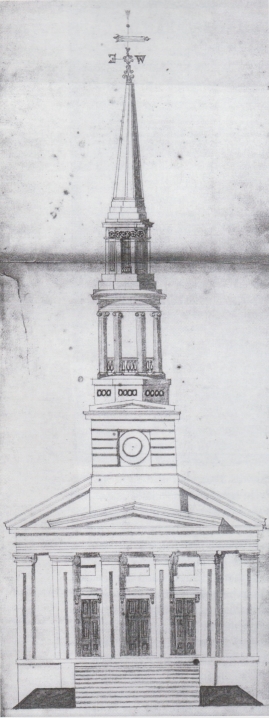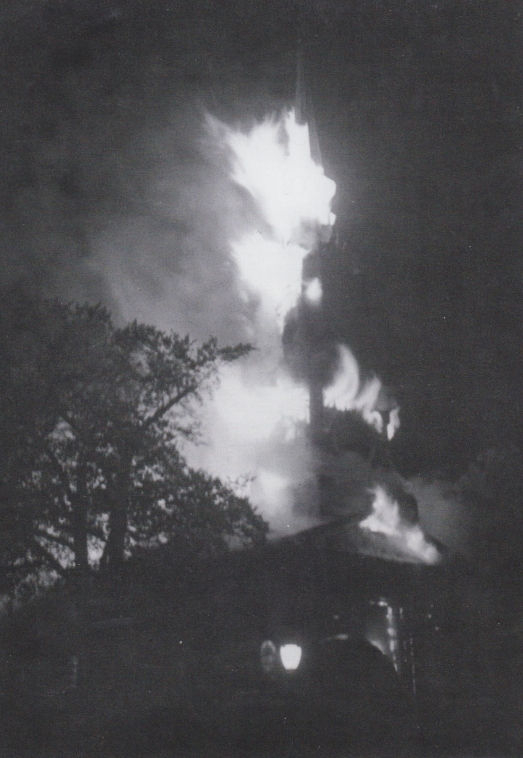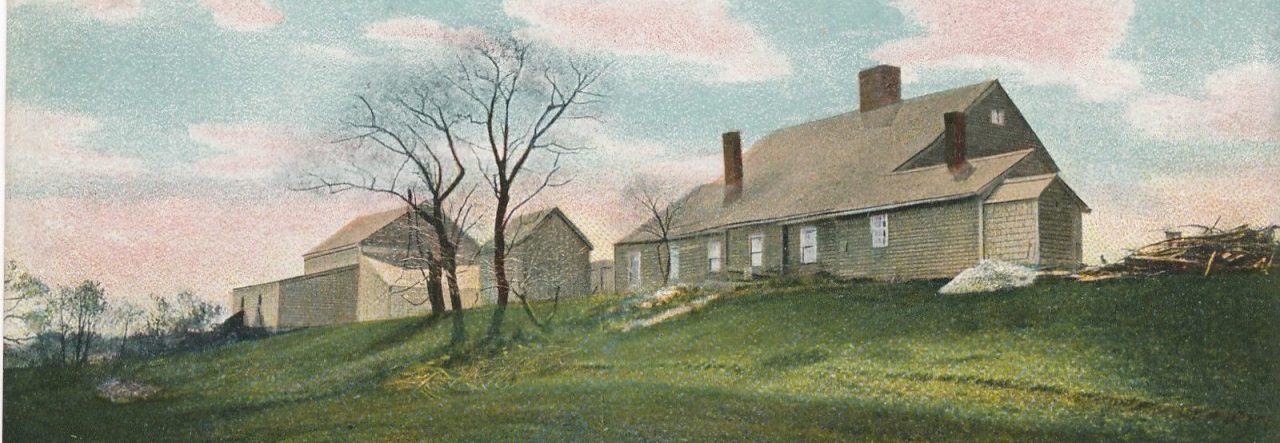(In the Herald-Citizen, 12/27/19)
 (Author’s photo, December 2019)
(Author’s photo, December 2019)
The Maple Street Church, originally known as the Third Orthodox Congregational Church of Danvers, was formed in 1844 and one year later a building was constructed on the site of its present church building on Maple Street. As the town grew, the church split off from the First Church of Danvers, and took the name Third Church because there was already a Second Congregational Church in the southern part of town that is now Peabody. This year marks the 175th anniversary of the Maple Street Church, an institution that has played a prominent role in the community for generations.
Danvers Plains, the area that includes Danvers Square, was quickly becoming the commercial center of town with the coming of the railroads, replacing the area surrounding the corner of Hobart and Centre Street that had served as the center of the community since it was Salem Village. This new church became a centerpiece of the new downtown, and the building hosted town meetings until town hall was built in 1855. During one of the town meetings held in the church in 1847, the people of Danvers voted on a resolution condemning the United States’ entry into the Mexican-American War, which was widely opposed in New England.

(Danvers Square in 1887, Maple Street Church is at the top labelled as “orthodox church.” Sanborn Fire Insurance Map.)
In 1836 American settlers in Texas declared independence from Mexico, partly so that the settlers could own slaves – which was illegal in Mexico – and Texas was later annexed by the U.S. as a slave state. In 1846 President James K. Polk sent U.S. troops over the Mexican border to provoke an attack, which he then used as a cause for the Mexican-American War. Abolitionist New England viewed the conflict as a ploy to add territory to the southern US and thereby expand slavery.
Rev. Richard Tolman delivered a sermon to the Maple Street Church on July 4, 1847 denouncing the “miseries and crimes of the Mexican War,” and connected it to the expansion of slavery as he decried “the dreadful waste of treasure and blood… for the purpose of extending and perpetuating that system of oppression.” Many members of the church, including Deacon Samuel Fowler whose brick house still stands at the Port Corner, were known for their strong abolitionist beliefs.

(The first church building, 1845-1850. Drawing by David S. Shattuck. Courtesy of the Danvers Archival Center, and printed in Martin, A Hearty Band of Firefighters.)
Though it quickly became the center of the Danvers community, the church suffered a terrible setback only five years after construction. At nine o’clock on the evening of July 10, 1850 two arsonists set fire to the building. The inferno was enormous, and threatened the whole neighborhood. The “General Putnam” engine company of volunteer firefighters from Danversport responded, its horse-drawn carriage galloping up High Street. When the firefighters arrived, men from the neighborhood joined them in combatting the flames. But, the church was lost.
During the fire, one man who volunteered to help the firefighters, William Duffy, had worked so hard that he won the respect of the fire company and returned to the engine house with them, where he was immediately voted in as a member of the volunteer company. Soon after, Duffy was arrested for being the accomplice of the man who set the fire that night.
Duffy was sentenced to life in the Charlestown State Prison, while the arsonist who turned state’s evidence apparently served no time. Well into his prison term, members of the church and the Danversport fire company captain lobbied to have him released early, finding it unjust that the man who had actually set the fire walked free while the accomplice was imprisoned. Duffy was released, and several years later enlisted to fight in the Civil War. He died fighting for the Union.
Despite the tragedy of the church burning down only years after it was established, a new church building was soon built and the congregation continued to grow quickly. When first established in 1844 the church counted only 42 people but by 1869 there were 200 members and by 1899 there were 751 members, with yet more attending services. That same year three of its members became some of the first western missionaries to visit China, which only recently began allowing western missions. The leaders of the church continued to be important in the wider community, and after pastor Rev. James Fletcher resigned from the Maple Street Church in 1864 he became the principal of Holten High School, the public high school in Danvers, from 1866-1871.

(The second church building, 1851-1944. Picture circa 1899, originally printed in Moynahan, Danvers, Massachusetts)
Fire struck the church again in the congregation’s hundredth anniversary year. Around 10pm on the night of May 20, 1944 one of the firefighters at the old central fire station looked out the window and saw flames reflected in a window across the intersection. A fire that began in a shed behind the church had quickly spread to the church building. The fire departments of seven towns fought the flames, fearing that they could easily spread to the neighboring gas station, the Maple Street Elementary School, and the railroad warehouse.

(The second church building burning in 1944. Courtesy of the Danvers Archival Center, and printed in Martin, A Hearty Band of Firefighters.)
Despite the multitude of firefighters and equipment, the fire raged through the grand wooden structure, and one hour after the fire was discovered the steeple collapsed into the church. In a sign of ecumenical and community-wide support for the church, at one point during the height of the inferno Fire Chief Joseph E. Kelley, Catholic priest Fr. Michael F. Collins, Superintendent of the Electric Light Dept. Leo Nimblett, Maple Street Church Deacon Carlton M. Stearns, and teenager Leland E. Martin Jr. (who later became a Danvers Fire Chief) ran into the basement of the burning church to rescue the congregation’s silver communion set. The church was rebuilt in 1948, the structure that stands today, and the rescued communion set is still used.

(The burned out church building, as seen on the Sunday following the fire in 1944. Courtesy of the Danvers Archival Center, and printed in Martin, A Hearty Band of Firefighters.)

(The clock from the church’s steeple lying on a pile of debris in the nave of the church. Courtesy of the Danvers Archival Center, and printed in Martin, A Hearty Band of Firefighters.)
At its 175th anniversary, the Maple Street Church’s congregation numbers approximately 375 people and the church’s services are broadcast on Danvers Community Access Television (DCAT). In addition to mission trips, the church sponsors Boy Scout Troop 16, is active in the Danvers Interfaith Partnership, and organizes numerous charitable endeavors.
—————————————————————————-
Sources:
Archer, Charles F. W. “Danvers.” In Standard History of Essex County, Massachusetts. Boston: C. F. Jewett and Company, 1878.
Hanson, J. W. History of the Town of Danvers from Its First Settlement to the Year 1848. Danvers: J.W. Hanson, 1848.
Hines, Ezra D., and W. J. C. Kenney. “Danvers Fires and Fire Companies.” The Historical Collections of the Danvers Historical Society 5 (1917): 84–85.
“Late Sentence for Incendiarism.” Gallipolis Journal. November 7, 1850. Library of Congress. https://chroniclingamerica.loc.gov/lccn/sn85038121/1850-11-07/ed-1/seq-3/.
Maple Street Church. “The InSpire.” Danvers: Maple Street Church, December 2019. https://www.maplestreetchurch.org/the-inspire.
Martin Jr., Leland E. A Hearty Band of Firefighters: The Illustrated History of the Danvers Fire Department. Edited by Richard P. Zollo. Danvers: The Danvers Historical Society, 1997.
“Old Danvers Church Destroyed by Fire With $100,000 Loss.” Daily Boston Globe, May 21, 1944.
Proceedings at the Celebration of the Two Hundredth Anniversary of the First Parish at Salem Village Now Danvers. Boston: Congregational Publishing Society, 1874.
Putnam, A.P. “Danvers People and Their Homes.” Historical Collections of the Danvers Historical Society 5 (1917): 74–83.
Sanborn Map Company. “Sanborn Fire Insurance Map from Danvers, Essex County, Massachusetts.” Danvers, Mass., November 1887. Library of Congress. https://www.loc.gov/item/sanborn03714_001/.
“Summary.” The Advent Herald. November 2, 1850. Adventist Digital Library.
Tapley, Charles Sutherland. “The One Hundredth Anniversary of the Maple Street Church.” The Historical Collections of the Danvers Historical Society 33 (1945): 16–21.
Tapley, Harriet S. Chronicles of Danvers (Old Salem Village), Massachusetts, 1632-1923. Danvers, Mass.: The Danvers Historical Society, 1923.
Tolman, Richard. Evil Tendencies of the Present Crisis: A Discourse, Delivered July 4, 1847. Danvers: The Danvers Courier, 1847. https://archive.org/details/eviltendenciesof00tolm/page/n4.
